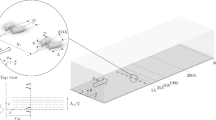Abstract
This work proposes a new simulation methodology to study variable density turbulent buoyant flows. The mathematical framework, referred to as homogeneous buoyant turbulence, relies on a triply periodic domain and incorporates numerical forcing methods commonly used in simulation studies of homogeneous, isotropic flows. In order to separate the effects due to buoyancy from those due to large-scale gradients, the linear scalar forcing technique is used to maintain the scalar variance at a constant value. Two sources of kinetic energy production are considered in the momentum equation, namely shear via an isotropic forcing term and buoyancy via the gravity term. The simulation framework is designed such that the four dimensionless parameters of importance in buoyant mixing, namely the Reynolds, Richardson, Atwood, and Schmidt numbers, can be independently varied and controlled. The framework is used to interrogate fully non-buoyant, fully buoyant, and partially buoyant turbulent flows. The results show that the statistics of the scalar fields (mixture fraction and density) are not influenced by the energy production mechanism (shear vs. buoyancy). On the other hand, the velocity field exhibits anisotropy, namely a larger variance in the direction of gravity which is associated with a statistical dependence of the velocity component on the local fluid density.
Similar content being viewed by others
References
Cook A.W., Cabot W., Miller P.L.: The mixing transition in Rayleigh–Taylor instability. J. Fluid Mech. 511, 333–362 (2004)
Cabot W.H., Cook A.W: Reynolds number effects on Rayleigh–Taylor instability with possible implications for type Ia supernovae. Nat. Phys. 2, 562–568 (2006)
Livescu D., Ristorcelli J.R.: Variable-density mixing in buoyancy-driven turbulence. J. Fluid Mech. 605, 145–180 (2008)
Livescu D., Ristorcelli J.R., Gore R.A., Dean SH., Cabot W.H., Cook A.W.: High-Reynolds number Rayleigh–Taylor turbulence. J. Turbul. 10, N13 (2009)
Livescu D., Ristorcelli J.R., Petersen M.R., Gore R.A.: New phenomena in variable-density Rayleigh–Taylor turbulence. Phys. Scr. T142, 014015 (2010)
Livescu D., Ristorcelli J.R.: Buoyancy-driven variable-density turbulence. J. Fluid Mech. 591, 43–71 (2007)
Chung D., Pullin D.I.: Direct numerical simulation and large-eddy simulation of stationary buoyancy-driven turbulence. J. Fluid Mech. 643, 279–308 (2010)
Batchelor G.K., Canuto V.M., Chasnov J.R.: Homogeneous buoyancy-generated turbulence. J. Fluid Mech. 235, 349–378 (1992)
Alvelius K.: Random forcing of three-dimensional homogeneous turbulence. Phys. Fluids 11, 1880–1889 (1999)
Lundgren T.S.: Linearly-forced isotropic turbulence. Annu. Res. Briefs Cent. Turbul. Res. 2, 461–473 (2003)
Rosales C., Meneveau C.: Linear forcing in numerical simulations of isotropic turbulence: physical space implementations and convergence properties. Phys. Fluids 17, 095106 (2005)
Eswaran V., Pope S.B.: An examination of forcing in direct numerical simulations of turbulence. Comput. Fluids 16, 257–278 (1988)
Eswaran V., Pope S.B.: Direct numerical simulations of the turbulent mixing of a passive scalar. Phys. Fluids 31, 506–520 (1988)
Yeung P.K.: Lagrangian characteristics of turbulence and scalar transport in direct numerical simulations. J. Fluid Mech. 427, 241–274 (2001)
Donzis D.A., Sreenivasan K.R., Yeung P.K.: The Batchelor spectrum for mixing of passive scalars in isotropic turbulence. Flow Turbul. Combust. 85, 549–566 (2010)
Watanabe T., Gotoh T.: Statistics of a passive scalar in homogeneous turbulence. New J. Phys. 6, 40 (2004)
Gotoh T., Hatanaka S., Miura H.: Spectral compact difference hybrid computation of passive scalar in isotropic turbulence. J. Comput. Phys. 231, 7398–7414 (2012)
Livescu D.: Numerical simulations of two-fluid turbulent mixing at large density ratios and applications to the Rayleigh–Taylor instability. Philos. Trans. R. Soc. A 371, 20120185 (2013)
Majda, A.: Compressible fluid flow and systems of conservation laws in several space variables. Appl. Math. Sci. 53, pp. 72–79 (1984)
Majda A., Sethian J.A.: Derivation and numerical solution of the equations of low Mach number combustion. Combust. Sci. Technol. 42, 185–205 (1985)
Desjardins O., Blanquart G., Balarac G., Pitsch H.: High order conservative finite difference scheme for variable density low Mach number turbulent flows. J. Comput. Phys. 227, 7125–7159 (2008)
Haworth D.C.: Progress in probability density function methods for turbulent reacting flows. Prog. Energy Combust. Sci. 36, 168–259 (2010)
Almgren, A., Bell, J., Nonaka, A., Zingale, M.: Low Mach number modeling of stratified flows. In: Finite Volumes for Complex Applications VII—Methods and Theoretical Aspects, Springer Proceedings in Mathematics & Statistics, vol. 77. Springer, Berlin (2014)
Soulard O., Griffond J., Grea B.-J.: Large-scale analysis of self-similar unstably stratified homogeneous turbulence. Phys. Fluids 26, 015110 (2014)
Carroll P.L., Blanquart G.: A proposed modification to Lundgren’s physical space velocity forcing method for isotropic turbulence. Phys. Fluids 25, 105114 (2013)
Carroll P.L., Verma S., Blanquart G.: A novel forcing technique to simulate turbulent mixing in a decaying scalar field. Phys. Fluids 25, 095102 (2013)
Mydlarski L., Warhaft Z.: On the onset of high-Reynolds-number grid-generated wind tunnel turbulence. J. Fluid Mech. 320, 331–368 (1996)
Carroll P.L., Blanquart G.: The effect of velocity field forcing techniques on the Karman–Howarth equation. J. Turbul. 15, 429–448 (2014)
Vallis G.K.: Atmospheric and Oceanic Fluid Dynamics: Fundamentals and Large-Scale Circulation. Cambridge University Press, New York (2006)
Morinishi Y., Vasilyev O.V., Ogi T.: Fully conservative finite difference scheme in cylindrical coordinates for incompressible flow simulations. J. Comput. Phys. 197, 686–710 (2004)
Harlow F.H., Welch J.E.: Numerical calculation of time-dependent viscous incompressible flow of fluid with free surface. Phys. Fluids 8, 2182–2189 (1965)
Kim J., Moin P.: Application of a fractional-step method to incompressible Navier–Stokes equations. J. Comput. Phys. 59, 308–323 (1985)
Pierce, C.D., Moin, P.: Progress-variable approach for large eddy simulation of turbulent combustion. Ph.D. thesis. Rep. TF80, Flow Physics and Computation Division, Dept. Mech. Eng. Stanford Univ. (2001)
Savard, B., Xuan, Y., Bobbitt, B., Blanquart, G.: A computationally-efficient, semi-implicit, iterative method for the time-integration of reacting flows with stiff chemistry. J. Comput. Phys. (2015). doi:10.1016/j.jcp.2015.04.018
Nourgaliev R.R., Theofanous T.G.: High-fidelity interface tracking in compressible flows: unlimited anchored adaptive level set. J. Comput. Phys. 224, 836–866 (2007)
Pope S.B.: Turbulent Flows. Cambridge University Press, Cambridge (2000)
Author information
Authors and Affiliations
Corresponding author
Additional information
Communicated by Sutanu Sarkar.
Rights and permissions
About this article
Cite this article
Carroll, P.L., Blanquart, G. A new framework for simulating forced homogeneous buoyant turbulent flows. Theor. Comput. Fluid Dyn. 29, 225–244 (2015). https://doi.org/10.1007/s00162-015-0350-0
Received:
Accepted:
Published:
Issue Date:
DOI: https://doi.org/10.1007/s00162-015-0350-0




